How Form and Structure of Chinese Characters Affect Eye Movement Control
Abstract
:Introduction
Hypotheses
Experiment 1
Method
Results
Experiment 2
Method
Results
Discussion
Conclusion
Acknowledgement
References
- Ai, W. Problem of traditional Chinese; National Translation and Compilation Center: Taipei, Taiwan, 1965. [Google Scholar]
- Baker, M. A.; Loeb, M. Implications of measurement of eye fixations for a psychophysics of form perception. Perception & Psychophysics 1973, 13(2), 185–192. [Google Scholar]
- Chaffin, R.; Morris, R. K.; Seely, R. E. Learning new word meanings from context: A study on eye movements. Journal of Experimental Psychology: Learning, Memory, and Cognition 2001, 27(1), 225–235. [Google Scholar] [CrossRef]
- Chao, C. Y. The gradation and mitigation for the complicacy of Chinese characters. Master’s thesis, Department of Industrial Design, National Cheng Kung University, Tainan City, Taiwan, 2005. [Google Scholar]
- Chen, C.; Huang, X. Research on characteristics of visual recognition to symmetrical structural Chinese characters. Acta Psychologica Sinica 1999, 31(2), 154–161. [Google Scholar]
- Chen, H. C.; Cheng, C. M.; Tseng, C. C.; Su, Y. J.; Jhan, Y. J. Effect on eye movement of regression inference of humor sentences. Paper presented at the 49th Annual Meeting of the Taiwanese Psychological Association, Chiayi City, Taiwan; 2010. [Google Scholar]
- Cheng, C. M. The progress of Chinese character cognition. Chinese Journal of Psychology 1981, 23, 137–153. [Google Scholar]
- Cheng, C. M.; Wu, S. C. Cang, H. W., Huang, J. T., Hue, E. W., Tzeng, O. J. L., Eds.; Orthographic satiation and disorganization in reading Chinese characters. In Advances in the study of Chinese language processing; Department of Psychology: Taipei, Taiwan, 1994; pp. 1–29. [Google Scholar]
- Flavell, J. H.; Draguns, J. A microgenetic approach to perception and thought. Psychological Bulletin 1957, 54, 199–217. [Google Scholar] [CrossRef]
- Gibson, E. J. Principles of perceptual learning and development; Prentice-Hall: Englewood Cliffs, NJ, 1969. [Google Scholar]
- He, X. Z.; Liao, D. Z. Analysis of the potential designing elements of Chinese characters. Journal of Beijing Institute of Graphic Communication 2011, 19(3), 73–75. [Google Scholar]
- Hsu, S. H.; Peng, Y.; Wu, S. P. Ergonomics; Yang-Chih Press: Taipei, Taiwan, 1991. [Google Scholar]
- Huang, J. S.; Ma, M. Y. A study on the cognitive of complexity and difficulty of Chinese characters when reading and recognizing. Displays 2007, 28, 8–25. [Google Scholar] [CrossRef]
- Hukuda, N.; Watanabe, T. Considering foreign language teaching from learner’s eye movement. Humanscape 1996, 4, 138–152. [Google Scholar]
- Just, M. A.; Carpenter, P. A. The role of eye-fixation research in cognitive psychology. Behavior Research Methods & Instrumentation 1976, 8, 139–143. [Google Scholar]
- Kliegl, R.; Nuthmann, A.; Engbert, R. Tracking the mind during reading: The influence of past, present, and future words on fixation durations. Journal of Experimental Psychology: General 135 2006, 12–35. [Google Scholar] [CrossRef]
- Koga, K.; Groner, R. Mandl, H., Levin, J. R., Eds.; Japanese character recognition and eye movements in non-Japanese subjects. In Knowledge acquisition from texts and pictures; Elsevier: Amsterdam, the Netherlands, 1989; pp. 279–291. [Google Scholar]
- Lin, P. C. Typography; Star Fox Press: Taipei, Taiwan, 2004. [Google Scholar]
- Mackworth, N. H.; Morandi, A. J. The gaze selects informative details within pictures. Perception and Psychophysics 1967, 2, 547–552. [Google Scholar] [CrossRef]
- Peng, R. X.; Yu, B. L. Chinese Society of General Psychology and Experimental Psychology, Ed.; Recognition of Chinese characters with different structures. In Selected papers on general psychology and experimental psychology; Gansu People’s Publishing: Gansu, China, 1983; pp. 182–184. [Google Scholar]
- Rayner, K.; McConkie, G. W. What guides a reader’s eye movements? Vision Research 1976, 16, 829–837. [Google Scholar] [CrossRef]
- Rayner, K.; Pollatsek, A. The psychology of reading; Prentice Hall: Englewood Cliffs, NJ, 1989. [Google Scholar]
- Reichle, E. D.; Pollatsek, A.; Fisher, D. F.; Rayner, K. Toward a model of eye movement control in reading. Psychological Review 1998, 105, 125–156. [Google Scholar] [CrossRef]
- Rumelhart, D. E.; McClelland, J. L. An interactive activation model of context effects in letter perception: Part 2. The contextual enhancement effect and some tests and extensions of the model. Psychological Review 1982, 89, 60–94. [Google Scholar] [CrossRef]
- Sanders, M. S.; McCormick, E. J. Human factors in engineering and design; McGraw-Hill: New York, 1987. [Google Scholar]
- Shen, M. W. Process of Chinese form identification. Unpublished doctoral dissertation, Hangzhou University, Zhejiang, China, 1992. [Google Scholar]
- Shen, M.; Zhu, Z. A study on the cognitive process of identification of Chinese characters with single component. Chinese Journal of Applied Psychology 1995, 2(2), 43–48. [Google Scholar]
- Shen, M.; Zhu, Z. A study of the similarity of single-component Chinese characters. Psychological Science 1997, 20(5), 401–405. [Google Scholar]
- Tamaoka, K.; Yamada, H. The effects of stroke order and radicals on the knowledge of Japanese kanji orthography, phonology and semantics. Psychologia 2000, 43, 199–210. [Google Scholar]
- Treisman, A.; Gelade, G. A. A feature integration theory of attention. Cognitive Psychology 1980, 12, 97–136. [Google Scholar] [CrossRef]
- Treisman, A.; Schmidt, H. Illusory conjunction in the perception objects. Cognitive Psychology 1982, 14, 107–141. [Google Scholar] [CrossRef]
- Tsai, D. C.; Huang, H. F.; Yu, W. L. A study of the legibility of simplified Chinese character and traditional Chinese character. Paper present at 2001 Annual Meeting of the Ergonomics Society of Taiwan, Taipei, Taiwan; 2001. [Google Scholar]
- Verdonschot, R. G.; La Heij, W.; Tamaoka, K.; Kiyama, S.; You, W. P.; Schiller, N. O. The multiple pronunciations of Japanese kanji: A masked priming investigation. Quarterly Journal of Experimental Psychology 2013, 66(10), 2023–2038. [Google Scholar] [CrossRef]
- Verdonschot, R. G.; Lai, J.; Feng, C.; Tamaoka, K.; Schiller, N. O. Constructing initial phonology in Mandarin Chinese: syllabic or sub-syllabic? A masked priming investigation. Japanese Psychological Research 2015, 57(1), 61–68. [Google Scholar] [CrossRef]
- Williams, L. M.; Loughland, C. M.; Green, M. J.; Harris, A. W. F.; Gordon, E. Emotion perception in schizophrenia: An eye movement study comparing the effectiveness of risperidone vs. haloperidol. Psychiatry Research 2003, 120(1), 13–27. [Google Scholar] [CrossRef]
- Yang, H. M.; McConkie, G. W. Wang, J., Infhoff, A. W., Chen, H. C., Eds.; Reading Chinese: Some basic eye movement characteristics. In Reading Chinese script: A cognitive analysis; Lawerence Erlbaum Associates: Mahwah, NJ, 1999; pp. 207–220. [Google Scholar]
- Yeh, S. L. Structure detection of Chinese characters: visual search slope as an index of similarity between different-structured characters. Chinese Journal of Psychology 2000, 42(2), 191–216. [Google Scholar]
- Yeh, S. L.; Li, J. L. Role of structure and component in judgments of visual similarity of Chinese characters. Journal of Experimental Psychology: Human Perception and Performance 28 2002, 933–947. [Google Scholar] [CrossRef]
- Yeh, S. L.; Jing, L. L.; Takeuchi, T.; Sun, V. C.; Liu, R. Effects of learning experience and age on the form categorization of Chinese characters. Visual Cognition 2003, 210(6), 729–764. [Google Scholar] [CrossRef]
- Yeh, S. L.; Li, J. L.; Chen, I. P. The perceptual dimensions underlying the classification of the shapes of Chinese characters. Chinese Journal of Psychology 1997, 39, 47–74. [Google Scholar]
- Yeh, S. L.; Li, J. L.; Chen, K. M. Classification of the shapes of Chinese characters: verification by different pre-designated categories and varied sample sizes. Chinese Journal of Psychology 1999, 40, 67–87. [Google Scholar]
- Yu, B.; Feng, L.; Cao, H.; Li, W. Visual perception of Chinese characters-effect of perceptual task and Chinese character attributes. Acta Psychologica Sinica 1990, 22, 141–147. [Google Scholar]
- Yu, W. L.; Tsai, T. C.; Chen, W. C. Effect of Chinese character forms on legibility; National Science Council: Taoyuan, Taiwan, 1996. [Google Scholar]
- Zhang, J.; Sheng, H. Study on the influence of the relationship of the wholes and their parts in the perceptual separation of Chinese characters. Acta Psychologica Sinica 1999, 31(4), 369–376. [Google Scholar]
- Zheng, Z. Gao, S. R., Zheng, Z. M., Eds.; The process of recognition of Chinese characters and words. In Psychological studies of the Chinese language; Wenhe Publishing Company: Hong Kong, China, 1982. [Google Scholar]
- Zhou, J. Q. Illusion; Guang xi fine arts publishing: Guangxi, China, 2004. [Google Scholar]





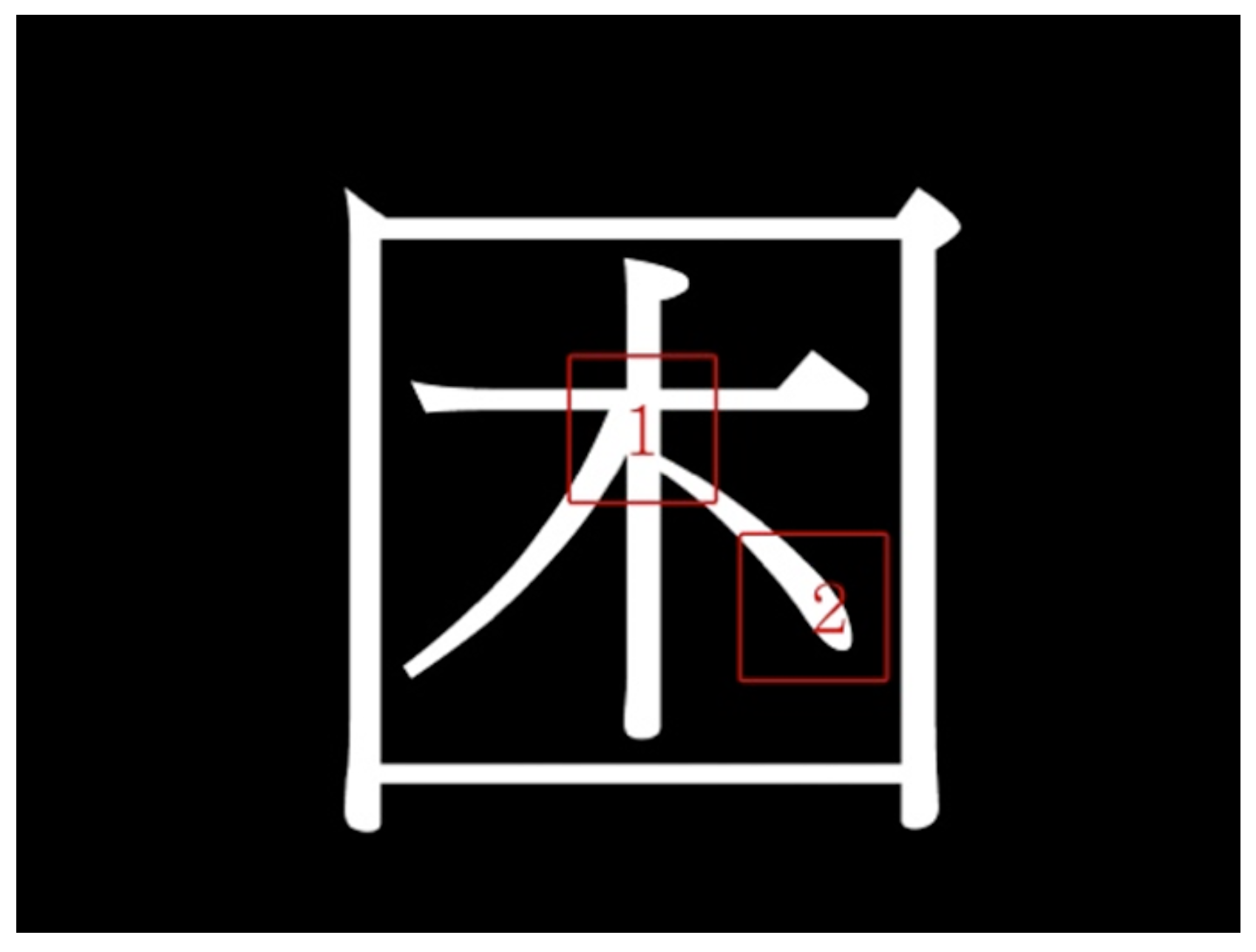
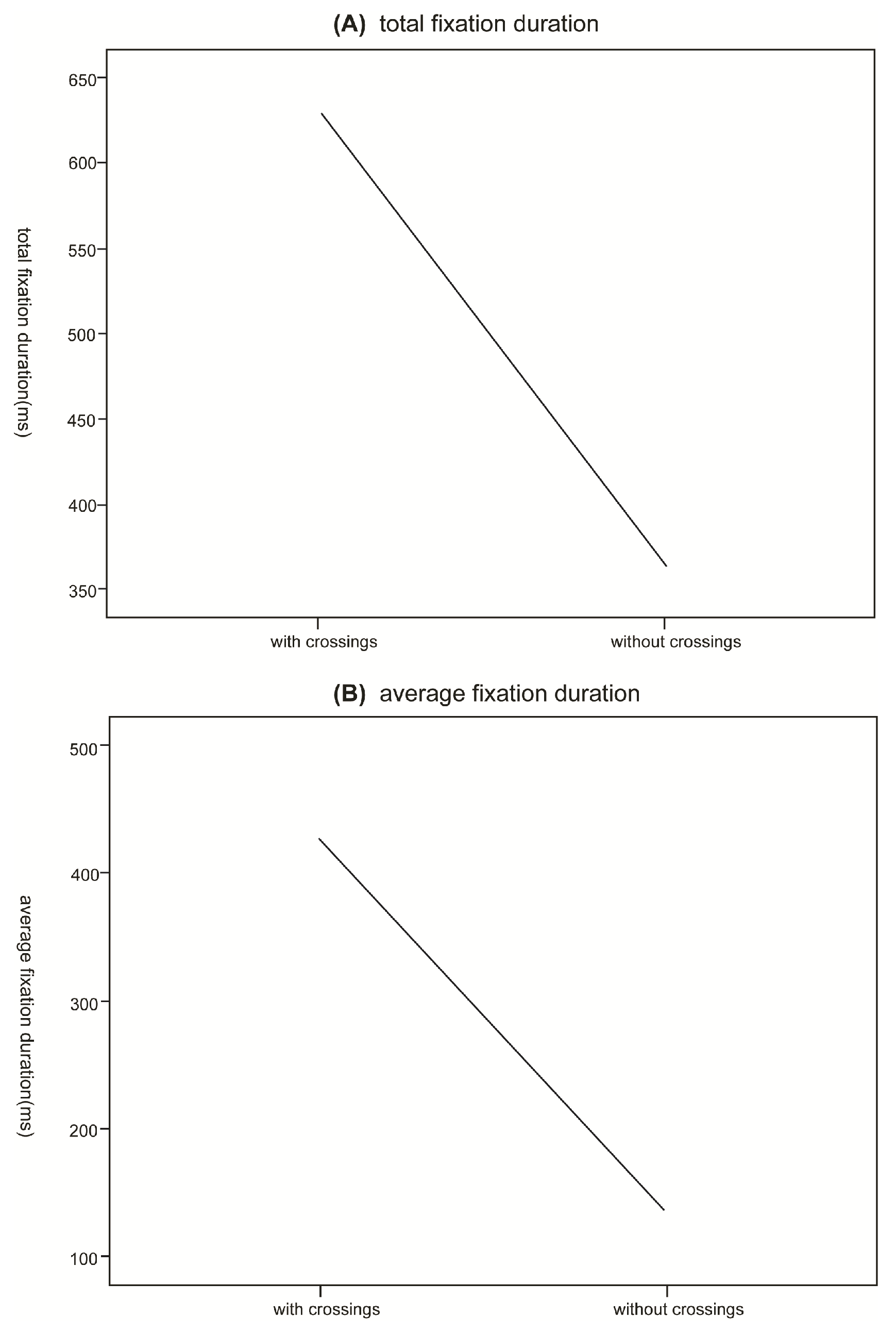
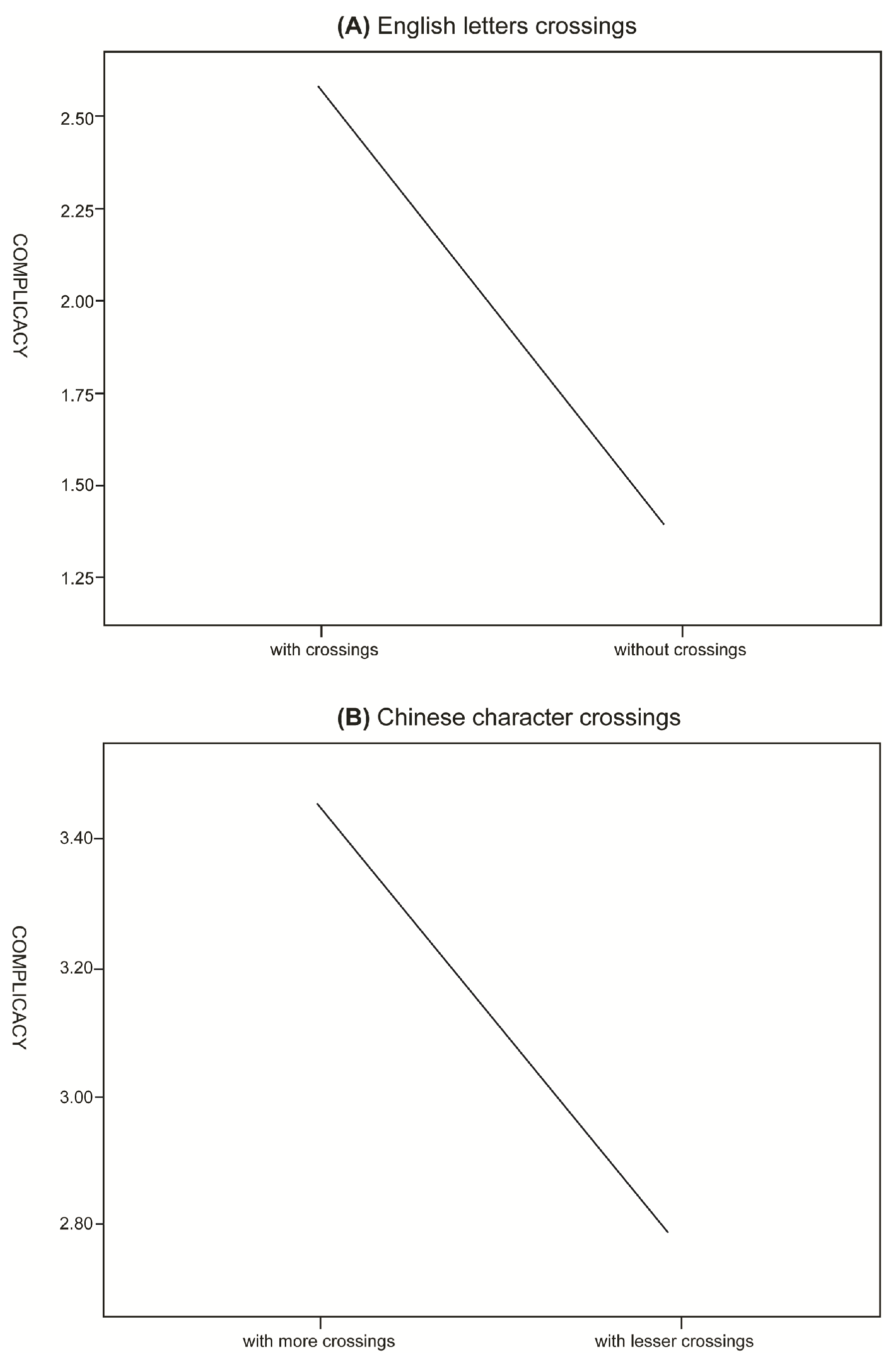
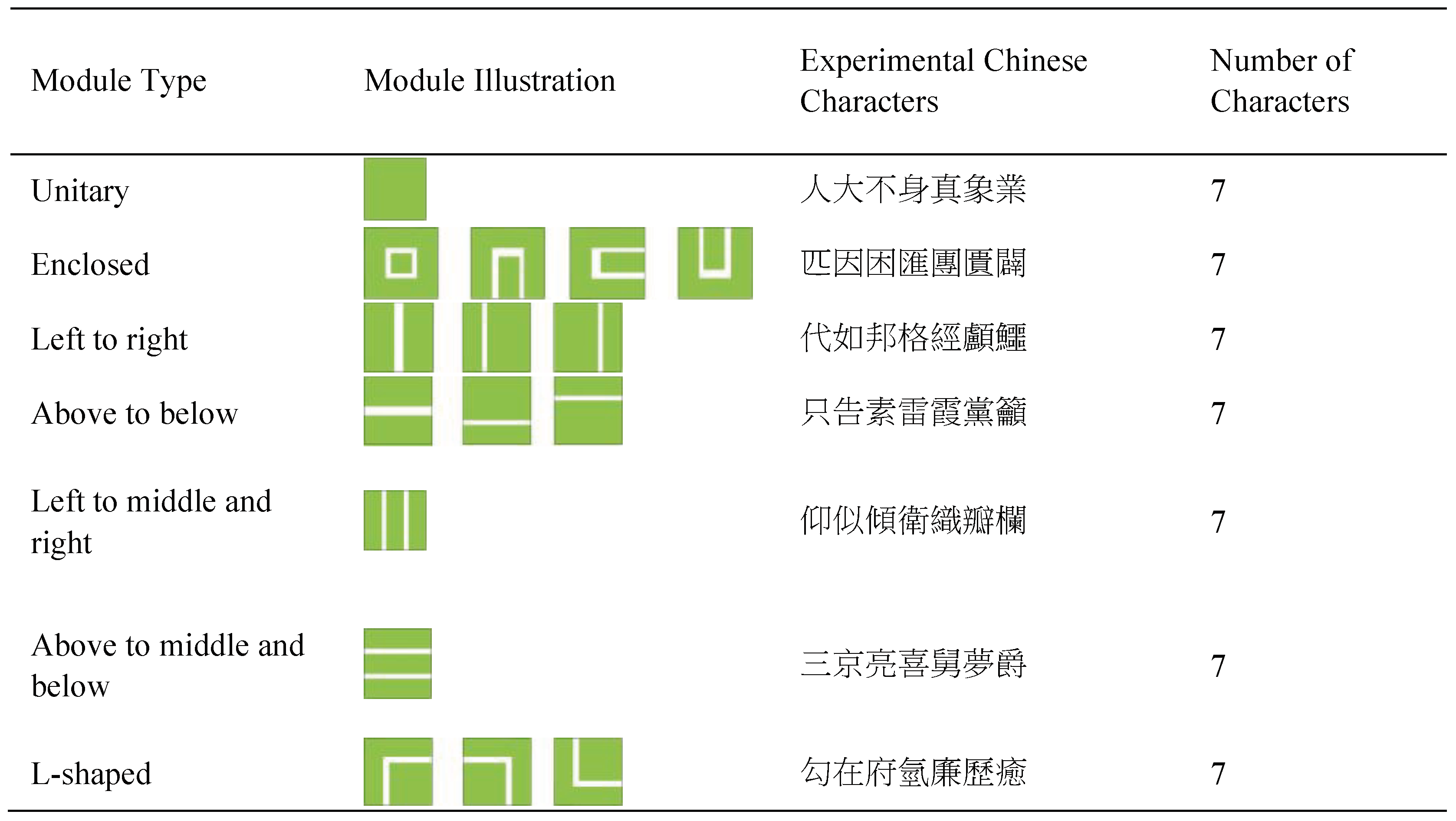 |
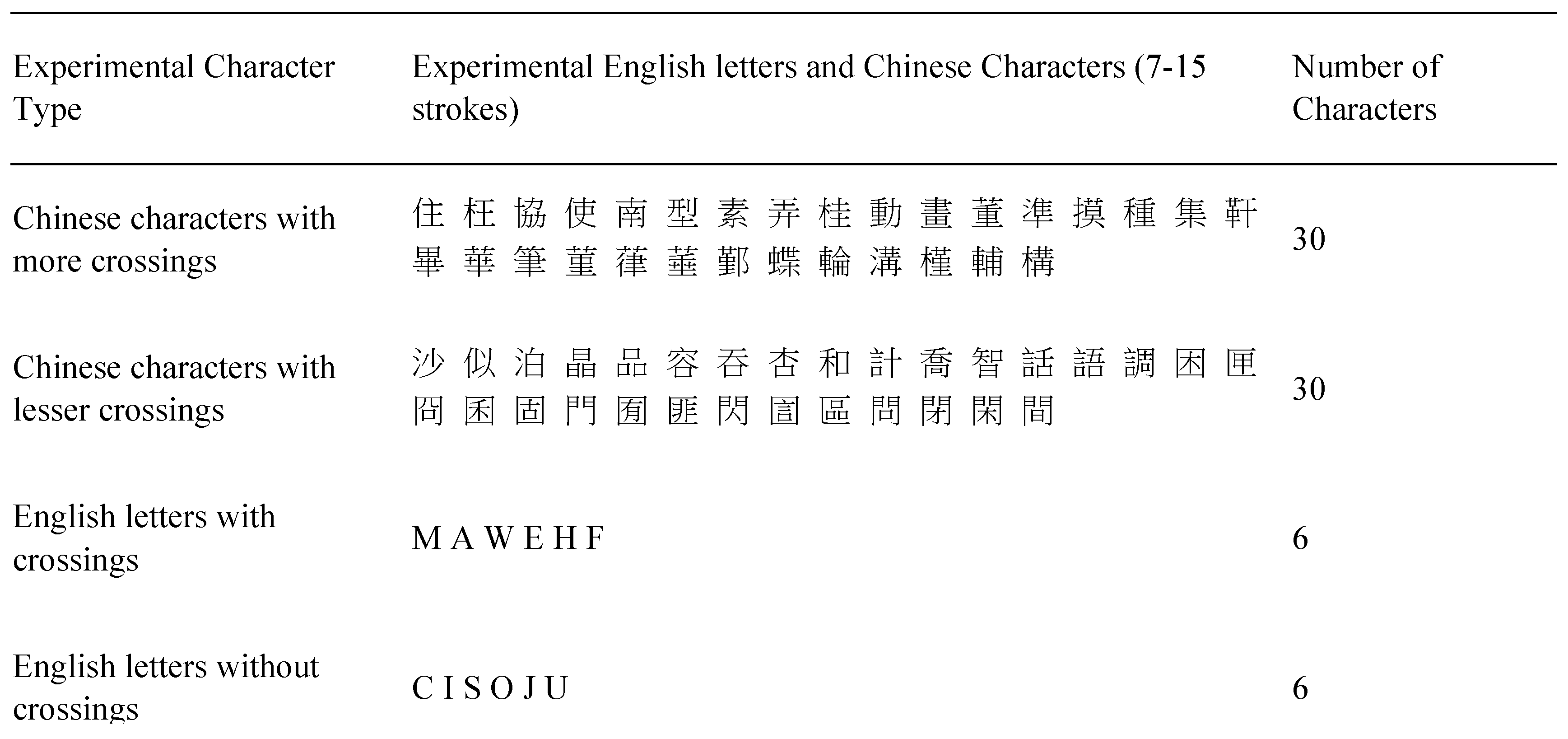 |
Copyright © 2015. This article is licensed under a Creative Commons Attribution 4.0 International License.
Share and Cite
Ma, M.-Y.; Chuang, H.-C. How Form and Structure of Chinese Characters Affect Eye Movement Control. J. Eye Mov. Res. 2015, 8, 1-12. https://doi.org/10.16910/jemr.8.3.3
Ma M-Y, Chuang H-C. How Form and Structure of Chinese Characters Affect Eye Movement Control. Journal of Eye Movement Research. 2015; 8(3):1-12. https://doi.org/10.16910/jemr.8.3.3
Chicago/Turabian StyleMa, Min-Yuan, and Hsien-Chih Chuang. 2015. "How Form and Structure of Chinese Characters Affect Eye Movement Control" Journal of Eye Movement Research 8, no. 3: 1-12. https://doi.org/10.16910/jemr.8.3.3
APA StyleMa, M.-Y., & Chuang, H.-C. (2015). How Form and Structure of Chinese Characters Affect Eye Movement Control. Journal of Eye Movement Research, 8(3), 1-12. https://doi.org/10.16910/jemr.8.3.3



